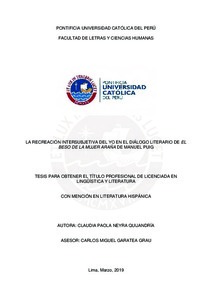| dc.contributor.advisor | Garatea Grau, Carlos Miguel | es_ES |
| dc.contributor.author | Neyra Quijandría, Claudia Paola | es_ES |
| dc.date.accessioned | 2019-04-29T20:24:05Z | es_ES |
| dc.date.available | 2019-04-29T20:24:05Z | es_ES |
| dc.date.created | 2019 | es_ES |
| dc.date.issued | 2019-04-29 | es_ES |
| dc.identifier.uri | http://hdl.handle.net/20.500.12404/14053 | |
| dc.description.abstract | Esta investigación busca sustentar una propuesta de interpretación de la novela El beso de la
mujer araña, del escritor argentino Manuel Puig. Tradicionalmente, la crítica literaria ha
propuesto interpretaciones centradas en su estructura dialogal, que renueva y subvierte el
canon de la narrativa latinoamericana de la década del 70; en su transgresión de los discursos
hegemónicos de la época en torno de la sexualidad y la política; en el diálogo entre narrativa
y cine que supone la obra de Puig. Este trabajo propone una interpretación distinta. En primer
lugar, se sostiene en los supuestos teóricos de la filosofía del lenguaje de Donald Davidson y
la novela polifónica de Mijail Bajtín. En segundo lugar, la metodología incluye dos
propuestas de acercamiento al texto literario: el análisis pragmático de Antonio Narbona y la
actitud metaforizante desarrollada por Jorge Wiesse. Es decir, partiendo de un acercamiento
intuitivo al texto de Puig, se presta atención a los detalles en el uso del lenguaje y en los
tópicos tratados para plantear una generalización. Esta se contrasta en cada capítulo con
nuevos detalles formales y de contenido, y así se genera un movimiento de vaivén (Spitzer
1982). En esa trayectoria de lo inductivo a lo deductivo, surge una lectura interpretativa
original: El beso de la mujer araña ofrece una metáfora del proceso de recreación
intersubjetiva de los protagonistas a través del diálogo. Valentín y Molina pasan del
internalismo en la comprensión de la realidad (el mundo es tal y como se lo imaginan en sus
mentes) al externalismo (el mundo se construye intersubjetivamente). Así se recrea
metafóricamente un proceso de transformación intersubjetiva del yo. Este se replica
metatextualmente, ya que, en cada nueva lectura interpretativa, no solo se recrea la ficción,
sino también la forma de concebir el texto literario por parte de los lectores.
Palabras clave: diálogo, internalismo, externalismo, intersubjetividad | es_ES |
| dc.description.abstract | The purpose of this research is to propose an interpretation of the novel entitled Kiss of the
Spider Woman, by Argentinian writer Manuel Puig. Traditionally, literary criticism has
proposed interpretations centered on its dialogical structure, which renews and subverts the
canon of the Latin American narrative of the 70s; on its transgression of the hegemonic
discourses of the time around sexuality and politics; on the dialogue between narrative and
cinema implied by Puig's work. This work proposes a different interpretation. First, it is
based on the theoretical assumptions of Donald Davidson's philosophy of language and
Mikhail Bakhtin's polyphonic novel. Secondly, the methodology includes two proposals for
approaching the literary text: the pragmatic analysis of Antonio Narbona and the
metaphorizing attitude developed by Jorge Wiesse. That is, starting from an intuitive
approach to Puig's text, attention is paid to the details in the use of language and in the topics
treated in order to propose a generalization. This is contrasted in each chapter with new
formal details and content, and thus a back and forth movement is generated (Spitzer 1982).
In this trajectory from the inductive to the deductive, an original interpretive reading
emerges: Kiss of the Spider Woman offers a metaphor of the process of intersubjective
recreation of the protagonists through dialogue. Valentín and Molina go from internalism in
the understanding of reality (the world is as they imagine it in their minds) to externalism (the
world is built intersubjectively). This metaphorically recreates a process of intersubjective
transformation of the self. This metatextually replicates, since, in each new interpretive
reading, not only the fiction is recreated, but also the way of conceiving the literary text by
the readers. | es_ES |
| dc.language.iso | spa | es_ES |
| dc.publisher | Pontificia Universidad Católica del Perú | es_ES |
| dc.rights | info:eu-repo/semantics/openAccess | es_ES |
| dc.rights.uri | http://creativecommons.org/licenses/by-nc-sa/2.5/pe/ | * |
| dc.subject | Puig, Manuel. El beso de la mujer araña--Crítica e interpretación | es_ES |
| dc.subject | Novela argentina--Siglo XX | es_ES |
| dc.title | La recreación intersubjetiva del yo en el diálogo literario de El beso de la mujer araña de Manuel Puig | es_ES |
| dc.type | info:eu-repo/semantics/bachelorThesis | es_ES |
| thesis.degree.name | Licenciado en Lingüística y Literatura con mención en Literatura Hispánica | es_ES |
| thesis.degree.level | Título Profesional | es_ES |
| thesis.degree.grantor | Pontificia Universidad Católica del Perú. Facultad de Letras y Ciencias Humanas | es_ES |
| thesis.degree.discipline | Lingüística y Literatura con Mención en Literatura Hispánica | es_ES |
| renati.discipline | 232126 | es_ES |
| renati.level | https://purl.org/pe-repo/renati/level#tituloProfesional | es_ES |
| renati.type | http://purl.org/pe-repo/renati/type#tesis | es_ES |
| dc.publisher.country | PE | es_ES |
| dc.subject.ocde | https://purl.org/pe-repo/ocde/ford#6.02.00 | es_ES |






